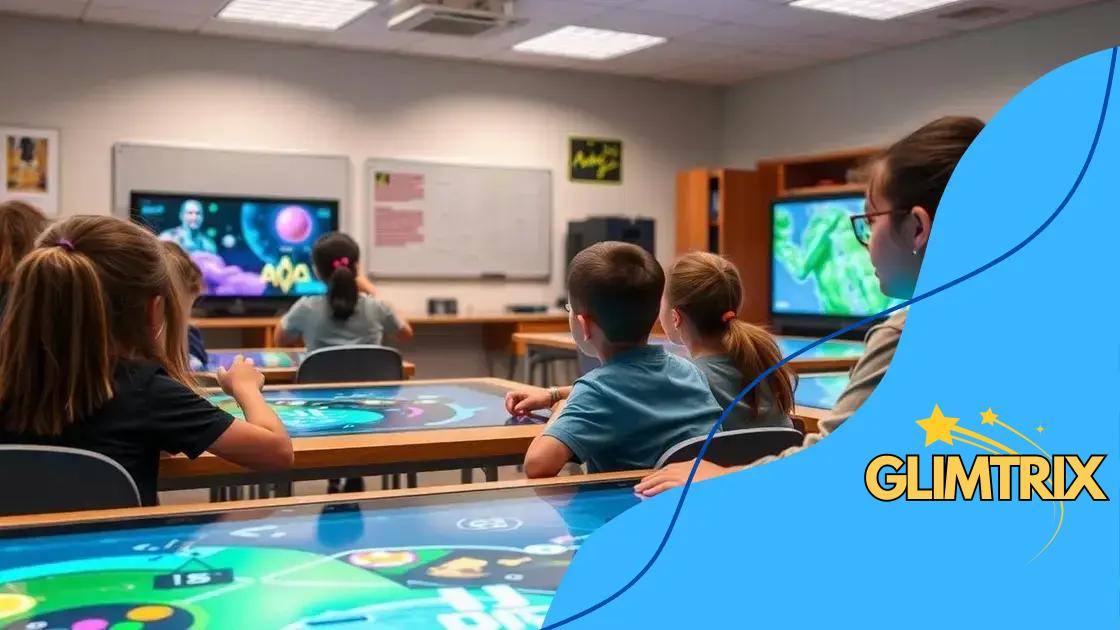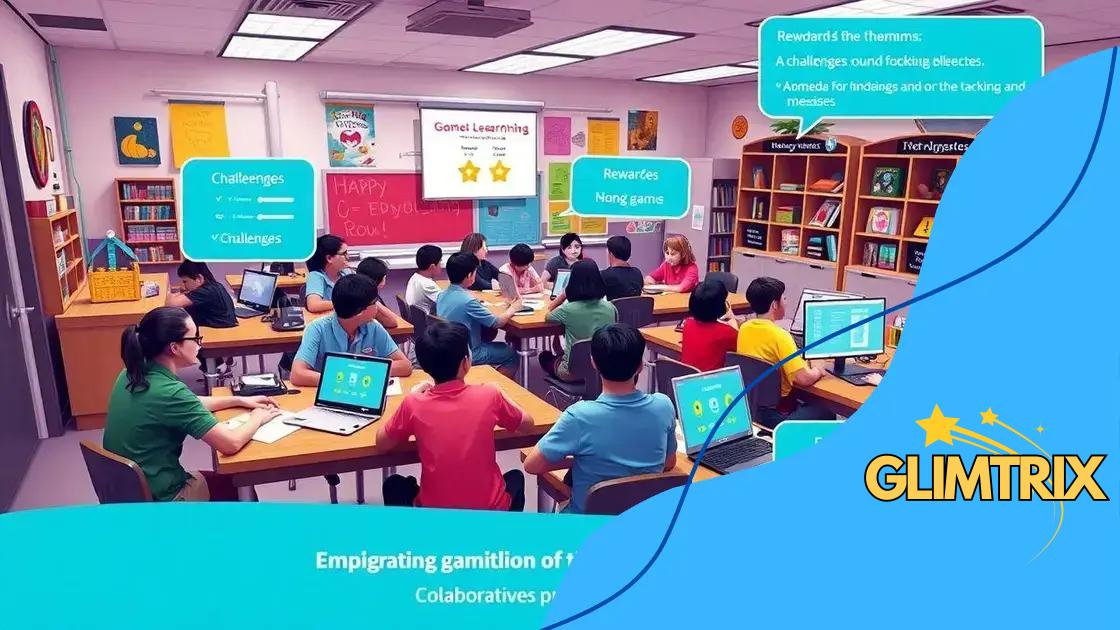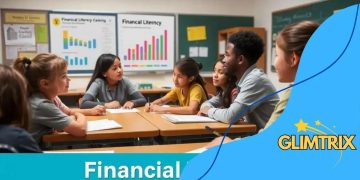Gamified learning to boost student retention

Gamified learning boosts student retention by using game elements like points, rewards, and challenges, making education more engaging and effective.
Gamified learning to boost student retention is revolutionizing education by making lessons engaging and interactive. Have you ever wondered how game mechanics can transform learning? Let’s dive in!
What is gamified learning?
Gamified learning refers to the use of game-like elements in educational settings to enhance student engagement. It turns traditional lessons into interactive experiences that capture attention and make learning fun.
Many educators are discovering this innovative approach. It combines aspects of games, such as point systems, challenges, and rewards, to motivate students. But what does that really look like in a classroom?
Key Components of Gamified Learning
To understand gamified learning, it’s important to recognize its core components:
- Points and Scores: Students earn points for completing tasks, encouraging them to improve.
- Levels: Just like in games, students can advance through different levels, unlocking new challenges and content.
- Badges: Digital or physical badges can reward achievements, fostering a sense of accomplishment and pride.
- Leaderboards: Sharing progress through leaderboards motivates students to strive for improvement and success.
When these elements come together, they create an environment where students feel empowered to learn at their own pace. Unlike typical lessons, which can often feel tedious or overwhelming, gamified learning offers a fresh approach filled with excitement.
Teachers can get creative with the activities. For example, integrating storytelling elements or themed challenges can enhance the experience even further. This dynamic style of teaching captivates students and drives their curiosity.
Benefits of Gamified Learning
One of the main advantages of gamified learning is improved retention. When students enjoy the learning process, they are more likely to remember the material. Additional benefits include:
- Increased motivation and engagement.
- Enhanced problem-solving skills through interactive challenges.
- Opportunities for collaboration among peers.
Implementing gamified learning can transform even the most mundane topics into exciting adventures. This method not only helps students grasp difficult concepts but also fosters a love for learning.
The impact of gamification on retention rates
The impact of gamification on retention rates has been studied widely. Implementing game elements in education can significantly improve how well students remember information. Traditional teaching methods often leave students unengaged, but gamification changes the game.
One important way this approach helps is through making learning more enjoyable. When students find lessons fun, they are more likely to pay attention and absorb the material. This leads to better retention of knowledge and skills.
Engagement and Motivation
When students are engaged, they are more motivated to learn. Gamification includes rewards and challenges that push students to participate actively. This active participation is key to better retention. Here are some ways gamification boosts engagement:
- Fun Challenges: Interactive and competitive scenarios motivate students to tackle tasks.
- Immediate Feedback: Students know how they are doing right away, allowing them to learn from mistakes quickly.
- Social Interaction: Group activities encourage collaboration and peer feedback.
This engaging format creates an exciting learning atmosphere. Students are not just passive recipients of information; they are active players in their education. This shift often results in higher retention rates.
Behavioral Changes
Another interesting effect of gamification is that it encourages behavioral changes among students. They start to enjoy the learning process, which further enhances their interest in subjects they previously found dull. Gamification helps students develop a sense of ownership over their learning journey.
The psychological benefits also play a critical role. Students find a sense of accomplishment when they earn points or badges, reinforcing their learning experiences. Research shows that when students experience achievement, they are likely to remember information long-term.
Essential elements of effective gamified learning

For effective gamified learning, certain key elements should be in place. These elements create a vibrant and engaging learning environment that captures students’ interest and enhances their educational experience. Understanding these components is crucial for educators.
First, clear objectives are essential. Students need to know what they are working towards. By setting clear goals, teachers can help students focus their efforts and track their progress.
Key Components of Gamified Learning
Once the objectives are established, integrating game mechanics becomes the next step. Here are some vital components:
- Challenge: Introducing tasks that are challenging but achievable keeps students motivated.
- Feedback: Offering immediate feedback allows students to know how they are doing and where they can improve.
- Rewards: Providing rewards for accomplishments fosters a sense of achievement and encourages continued effort.
- Storytelling: Using narratives can engage students, making the learning experience more relatable and enjoyable.
Incorporating these elements creates a rich tapestry of experiences that can significantly enhance student retention and engagement. By intertwining educational content with engaging aspects of gaming, students are more likely to stay interested and invested in their learning.
Creating an Engaging Environment
Another important aspect of effective gamified learning is the environment. A supportive and interactive atmosphere encourages students to explore and take risks. This helps build their confidence. When students feel safe to experiment, they are more likely to absorb the material. Additionally, incorporating collaboration through group activities helps students learn from each other.
Furthermore, using technology can enhance the gamified experience. Interactive platforms and digital tools can facilitate a more immersive learning process, allowing students to engage with the content actively. Overall, these essential components work together to create a transformative educational experience that fosters a love for learning.
Real-world examples of gamified education
Real-world examples of gamified education show how this innovative approach transforms learning. Many schools and institutions are using gamification to enhance student engagement and retention effectively.
One inspiring example is the Kahoot! platform. In this interactive tool, teachers create quizzes that students can answer on their devices. With a competitive spirit, students earn points for correct answers and speed, making learning fun and engaging. This instant feedback helps reinforce concepts.
Other Notable Examples
Several organizations have also integrated gamification into their teaching methods:
- Classcraft: This platform turns the classroom into an adventure. Students create characters and earn experience points by completing assignments and behaving well. This motivates them to engage with their learning.
- Duolingo: A popular language learning app, Duolingo uses gamification by rewarding users with points and badges. The app’s daily challenges encourage consistent practice while learning new languages.
- Epic Win: This productivity app encourages users to complete real-life tasks by turning them into quests. By completing tasks, users earn points, helping to make everyday responsibilities more engaging.
Through these examples, it’s clear that gamified education can lead to greater motivation and interest among students. Each of these tools incorporates game-like elements that make learning enjoyable, yet effective.
Benefits Observed in Implementations
Institutions that have adopted gamified learning often report significant improvements in student participation and learning outcomes. This approach fosters a sense of community as students sometimes collaborate to achieve their gaming objectives.
As more educators embrace these techniques, the future of education looks promising. Gamification can adapt to different subjects and age groups, providing a versatile framework for modern learning.
Tips for implementing gamification in classrooms
Implementing gamification in classrooms can transform the learning experience. Educators can make lessons more engaging and effective by incorporating game elements into their teaching methods. Here are some practical tips for teachers who want to adopt this approach.
Start Simple
When introducing gamification, it’s best to keep things simple at first. Begin with small elements like points for participation or rewards for achievements. This allows students to adjust to the new system without feeling overwhelmed.
- Use Points: Award points for completing homework, contributing in class, or helping classmates.
- Set Clear Goals: Clearly define what students need to accomplish to earn rewards or move to the next level.
- Create Challenges: Design fun challenges that encourage collaboration and competition among students.
As students become comfortable with these new elements, teachers can gradually introduce more complex gamified features.
Incorporate Technology
Utilizing technology can enhance gamification in classrooms. Many apps and platforms are designed specifically for this purpose. Tools like Kahoot! or Classcraft can provide fun and interactive ways for students to engage with lessons. By incorporating technology, lessons become more dynamic and accessible.
Moreover, digital platforms often offer instant feedback, allowing students to understand their progress in real time. This immediate response can be motivating and help students learn from their mistakes quickly.
Foster Collaboration
Encouraging teamwork can enhance the benefits of gamified learning. Create team-based challenges where students work together to achieve goals. This builds a sense of community and encourages social interaction.
- Group Projects: Assign collaborative projects where students can earn points together.
- Peer Feedback: Create opportunities for students to give and receive feedback from their peers.
- Team Competitions: Organize friendly competitions between groups to foster a supportive environment.
Overall, fostering collaboration helps students develop important social skills while keeping them engaged in the learning process.
Regularly Assess and Adapt
Finally, it’s critical to regularly assess the effectiveness of your gamification strategy. Gather feedback from students to see what is working and what can be improved. This will help ensure that the gamified elements remain relevant and beneficial.
Adjust your methods based on student engagement and performance. This adaptability allows teachers to create a dynamic learning environment that meets the needs of all learners.
FAQ – Frequently asked questions about gamified learning
What is gamified learning?
Gamified learning uses game-like elements such as points, badges, and challenges to enhance student engagement and retention in educational settings.
How can gamification improve student motivation?
By incorporating rewards and competitions, gamification makes learning more enjoyable, encouraging students to participate actively and complete tasks.
Are there effective tools for implementing gamification?
Yes, platforms like Kahoot!, Classcraft, and Duolingo offer interactive features that facilitate gamified learning experiences in the classroom.
What are some benefits of using gamification in education?
Gamification can lead to improved student engagement, better retention of information, enhanced collaboration among peers, and increased motivation to learn.





